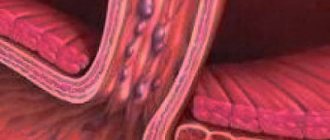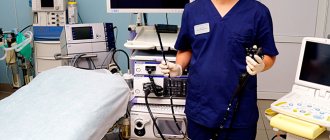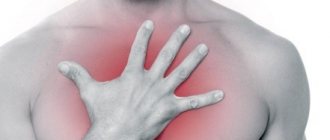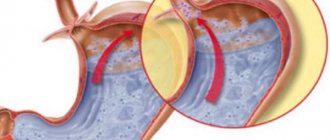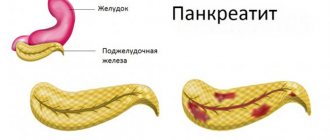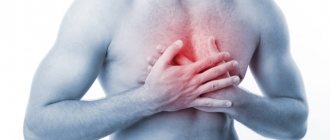Axial hiatal hernia is a progressive disease caused by weakening of the ligamentous apparatus of the diaphragm and manifested by the movement of abdominal organs (terminal segment of the esophagus, stomach, intestines) through an enlarged esophageal diaphragmatic opening into the cavity of the posterior mediastinum. Depending on how pronounced this movement is and how many organs it affects, three degrees of the disease are distinguished. The main symptoms of the disease: pain in the xiphoid process, heartburn, belching. The decisive diagnostic methods are X-ray examination with contrast of the esophagus and endoscopy. Treatment includes diet, conservative therapy and surgery.
Axial hiatal hernia - what is it?
A hiatal hernia is a movement of abdominal organs through an enlarged esophageal hiatus into the posterior mediastinum.
Axial hiatal hernias can be congenital or acquired.
In children, this pathology is associated with a violation of embryogenesis, leading to the formation of a short esophagus. The anomaly requires surgical correction in early infancy.
In adults, the disease is associated with involutional processes, resulting in dystrophy and atrophy in the ligamentous apparatus of the diaphragm that holds the esophagus. The esophageal opening of the diaphragm stretches and widens, which creates conditions for the penetration of abdominal organs into the posterior mediastinum.
The occurrence of hernias is facilitated by sharp single or chronic increases in intra-abdominal pressure (frequent constipation, coughing, sudden lifting of weight, blunt abdominal trauma).
Classification and types of diaphragmatic hernias
Depending on the anatomical features, they are distinguished:
- Axial (sliding, axial) hernias, when the abdominal part of the esophagus and the associated cardiac part of the stomach penetrate into the chest. Depending on the position of the patient’s body, the abdominal organs either penetrate into the posterior mediastinum or again slide downwards from the diaphragm.
- Paraesophageal hernias are those when the terminal part of the esophagus and the associated cardiac part of the stomach are in the abdominal cavity, and the fundic and even antral parts of the stomach penetrate through the enlarged esophageal opening.
A combined pathology is rarely observed when there is a sliding hiatal hernia and a paraesophageal hernia in the same patient.
Depending on how pronounced the penetration of the abdominal organs into the chest is, there are 3 degrees of severity of axial hernias.
- 1st degree - the terminal section of the esophagus is located above the diaphragm, the cardia (cardiac sphincter) is located at the level of the diaphragm, and the stomach from the abdominal cavity is adjacent to the diaphragm;
- 2nd degree – complete displacement of the terminal part of the esophagus into the posterior mediastinum, the stomach is located in the area of the esophageal opening of the diaphragm;
- 3rd degree - cardiac, fundal, and sometimes the entire stomach is located in the chest cavity.
Symptoms and treatment of hiatal hernia depend on the severity of the hernia process:
- in grade 1, when the clinical picture is minimally expressed, treatment is conservative (diet, general health measures);
- in grade 2 – diet, medication, and sometimes surgery;
- for grade 3 – surgical treatment.
Characteristic symptoms
In the initial stages, the pathology occurs with minimal symptoms, which seriously complicates the establishment of a correct diagnosis and leads to delays in treatment. However, if you are alert to certain signs, it is quite possible to recognize the disease in a timely manner.
The symptoms of a hiatal hernia depend on its type and degree:
(if the table is not completely visible, scroll to the right)
| Type of hernia | Symptoms |
| Axial 1st degree |
|
| Axial 2 degrees |
|
| Paraesophageal | Symptoms associated with stomach prolapse:
Cardiorespiratory symptoms occur when the formation is large and is associated with the fact that it compresses the lungs and heart:
|
| Combined | A combination of different symptoms. |
Axial hiatal hernia 1st degree - what is it?
Axial hiatal hernia of the 1st degree is the earliest stage of the disease, when only the distal part of the esophagus is located in the chest, the transition zone of the esophagus to the stomach is at the level of the esophageal opening, and the stomach itself is located below the diaphragm, directly in contact with it.
Symptoms of stage 1 hiatal hernia
Hiatal esophageal hernia with this degree of disease occurs with minimal symptoms. Patients note slight discomfort in the epigastrium and retrosternal region, which intensifies after a heavy meal, when bending over, and during physical activity. Heartburn and belching also occur in these situations, but they are even less common. The disease is rarely detected at this stage. Stage 1 hiatal hernia is usually treated with non-drug means.
Treatment
If a sliding hiatal hernia of the 1st degree is detected, and this often happens by chance, a complex of conservative non-drug therapy is prescribed. Non-drug treatment includes:
- diet is the basis of all treatment, table No. 1 according to Pevzner is prescribed, individual changes to the diet are made by the attending physician, taking into account the concomitant pathology;
- the patient needs to eat regularly, at the same time, in small portions, increasing the number of meals, food should be boiled (or steamed), soft, warm;
- heavy physical activity is contraindicated for the patient, but physical activity cannot be completely excluded (swimming, walking are recommended, a set of breathing exercises is recommended);
- the patient should have full rest at night (the head of the bed should be elevated by 20 cm);
- completely eliminate alcohol and cigarettes;
- Vitamins and antihistamines are prescribed as medications.
Reflux (reflux of gastric contents into the esophagus) does not occur with an axial hernia of the 1st degree.
Diagnostics
Pathology is often identified when determining the causes of gastric contents reflux into the esophagus, pain in the chest and/or abdomen.
To establish a diagnosis, the following is carried out:
- endoscopic examination - will exclude other diseases of the digestive tract, in which similar symptoms may be observed;
- stool test for occult blood - to exclude bleeding in the gastrointestinal tract;
- X-ray examination - may be required to exclude diseases of the respiratory system;
- ECG (electrocardiography) – for the purpose of differential diagnosis with diseases of the cardiovascular system.
What is axial hiatal hernia 2nd degree
Axial hiatal hernia of the 2nd degree is a stage of the disease when the distal esophagus and gastroesophageal junction penetrate into the posterior mediastinum through the dilated esophageal opening. Sliding hiatal hernia of the 2nd degree should be treated with medication.
Symptoms
With a sliding hiatal hernia of the 2nd degree, part of the stomach moves into the posterior mediastinum, resulting in the appearance of symptoms and signs of compression of the stomach: pain and gastroesophageal reflux. The pain is aching, localized in the retrosternal region, it is often accompanied by extrasystoles and increased blood pressure, which requires differential diagnosis with cardiac pathology.
Gastroesophageal reflux, caused by insufficiency of the cardia rosette, provokes the development of esophagitis:
- a burning sensation appears along the entire esophagus;
- heartburn;
- belching;
- a sour taste appears in the mouth;
- changes in gastric motility lead to indigestion with frequent constipation followed by diarrhea;
Treatment
Treatment of hiatal axial hernia of the 2nd degree is aimed at eliminating the pain syndrome, as well as the damaging effect of reflux on the esophageal mucosa. For treatment, drugs and methods of pathogenetic action are used:
- diet therapy in compliance with nutritional rules;
- drugs that reduce the aggressive effect of H+ ions on the esophageal mucosa by neutralization (antacids - Phosphalugel, Almagel), by reducing their formation in the stomach - PPI (Omeprazole, Rabeprazole) and IGR (Famotidine, Ranitidine);
- drugs that enhance gastric and intestinal motility (prokinetics - Itopride, Domperidol);
- antispasmodics (No-Shpa);
- metabolism (Riboxin).
What is a hiatal hernia?
Hiatal hernia is one of the most misunderstood and most often misunderstood diseases in the entire medical field: patients are conditioned to give hiatal hernia more defects than it actually is.
It is therefore important that, especially those who personally suffer from this condition, they understand the disease and the possible complications that can be encountered more fully.
From an anatomical point of view, a hernia consists of the passage (herniation) of part of the stomach through an opening in the diaphragm, the muscle that supports the lungs and separates the chest cavity from the abdominal cavity.
A hiatal hernia often causes gastroesophageal reflux, a condition characterized by the following symptoms:
- heartburn and chest pain,
- difficulty swallowing,
- dry cough,
- bad breath.
However, note that many patients have hiatal hernias without reflux, while others suffer from reflux without developing a hernia.
In most cases, a small hernia does not cause problems and its presence can be ignored throughout life, so in many patients the diagnosis is made completely by chance during medical examinations needed for other reasons (the subject is more common over 50 years of age); in this situation no type of therapy is required.
A large hernia, on the other hand, allows food and acids from the stomach to return to the esophagus, causing a burning sensation and other visible symptoms.
In most patients, the underlying cause remains unknown; it has been suggested that this may be due to weakness of the surrounding muscles and the concomitant effect of increased abdominal pressure, e.g.
- cough,
- vomit,
- constipation efforts,
- lifting heavy objects or other physical exertion.
Less commonly, it may be due to injury or birth defects (that is, present from birth). Obesity and smoking may increase the risk of occurrence.
There is very little chance of this type of hernia causing more serious problems, and often with small daily adjustments and perhaps drug use, an excellent quality of life can be restored.
For example, it is desirable:
- eat small frequent meals instead of two very large meals,
- avoid eating certain foods,
- do not smoke or drink alcohol,
- lose weight if necessary.
Finally, the need to resort to surgery is rare, the only approach that can be considered as a definitive cure, but which rarely needs to be resorted to.
Axial hiatal hernia 3rd degree: what is it and how to treat
Axial hiatal hernia of the 3rd degree is a condition when most of the stomach, and in some cases the entire organ along with intestinal loops, penetrates into the chest through a distended esophageal opening. This is the most severe degree of the disease, leading to severe complications. Sliding hiatal hernia is treated mainly surgically.
Symptoms and signs
With grade 3 axial hiatal hernia, the clinical picture is clear and is determined by the symptoms of peptic esophagitis, chronic gastropathy (stomach diseases) and complications developing against this background.
The main symptoms of a hiatal hernia of the 3rd degree:
- heartburn;
- pain in the retrosternal region;
- dysphagia;
- belching;
- salivation;
- vomiting with blood;
- melena.
Hiatal axial hernia 3rd degree: treatment
Hiatal hernia of the 3rd degree is a serious condition, so treatment includes:
- diet therapy;
- non-drug methods of influencing pathology;
- drug treatment;
- surgical operations.
Surgical treatment is indicated:
- if drug therapy is ineffective;
- if complications occur (bleeding, ulcers, strictures, strangulated hernia, Barrett's esophagus);
If the operation is performed on time, in the absence of severe consequences of a gastric hernia, after the rehabilitation period, a complete recovery is possible. Relapses after surgical treatment are rare.
Hiatal hernia: types, clinical picture, etiology, methods of treatment and prevention
A hiatal hernia appears in the area of the diaphragmatic opening of the esophagus. This is the most common pathology among all diaphragmatic hernias. It is most often diagnosed in women and the risk of its occurrence increases with age. Its other name is hiatal hernia or hiatal hernia.
What is a hiatal hernia? This is a chronic disease of a recurrent nature, in which, through an enlarged diaphragmatic opening, protrusion into the chest cavity of the lower (abdominal) portion of the esophagus, stomach, and less commonly other organs of the abdominal cavity occurs.
What is a grade 1 sliding hiatal hernia? With this course of the disease, only the esophagus protrudes into the chest cavity, and the stomach is localized above its anatomical position closer to the diaphragm. If a sliding hernia of the 1st degree is found in patients of an older age group, then it is considered a borderline condition that develops as a result of age-related changes.
Diagnostic algorithm and main methods of therapy
Competence of treatment largely depends on making the correct diagnosis.
The tasks of the diagnostician to identify this pathology, its type and severity are to carry out the following activities:
- collecting anamnesis based on the initial examination and patient complaints;
Fecal occult blood test
As for treatment, it should be selected exclusively by an experienced specialist and be based, first of all, on the general clinical picture of the disease, the severity of certain symptoms, and the severity of the disease.
In medical practice, there are two directions of treatment: a conservative method and a radical one , where the first is based on the use of medicinal drugs and an accompanying restorative diet and lifestyle, while the second is based solely on surgical intervention.
Conservative and surgical treatment
So, at the initial stage of development of the disease and the absence of pronounced symptoms, you can often get by with the following treatment methods:
- special therapeutic diet , in which it is recommended to completely exclude salty, spicy and fried foods from your diet, which additionally irritate the mucous walls of the esophagus. Such dietary meals should be fractional, and the foods consumed should be crushed to a mushy state, which will ease the work of the stomach and reduce the load on the gastrointestinal tract.
Reference! In cases where one of the reasons for the development of a hernia in a patient is a prolonged cough, it is necessary to take antitussives and concomitant treatment of the root cause of the cough syndrome.
In more advanced cases, which can lead to various complications, or in the absence of the desired effect as part of the patient’s drug treatment, surgical intervention .
Hiatal hernia surgery
As practice shows, operations are prescribed for patients who have combined and paraesophageal hernia . This fact is due to the fact that in the presence of precisely these types of diseases complications appear. The main essence of the surgical method is to suturing the opening of the diaphragm, which subsequently eliminates the possibility of organs slipping through it, as well as fixing the stomach to the abdominal wall.
Change in color of the hiatal hernia up to necrosis
Diagnosis and treatment
Timely detection and treatment of a diaphragmatic hernia will help avoid complications from the gastrointestinal tract, including the pancreas. Hiatal hernia can be diagnosed using a special esophagoscope apparatus. The doctor examines the esophagus. To rule out cancer, a biopsy is taken. You can also diagnose this disease using x-rays. As a rule, large hernias are detected this way. Clinical tests are required. They will help identify signs of bleeding, reflux, and anemia.
Treatment of this disease is aimed at reducing symptoms and alleviating the patient’s condition. The patient is advised to adhere to a diet and not to overload the stomach. Drug therapy is also prescribed:
- Medicines that reduce reflux symptoms. Their action is aimed at preventing acid from the stomach from entering the esophagus.
- Enzyme preparations that help the stomach digest food faster and thereby reduce tension in the stomach.
- Medicines that reduce the amount of stomach acid.
If symptoms indicate the presence of a paraesophageal hernia, then surgery may be recommended. It is aimed at eliminating gastroesophageal reflux, as this is the most pronounced symptom. Using a laparoscope, the doctor reduces the hole and pushes the protruding part of the stomach into place.
After this, a cuff is created from the walls of the stomach, which will hold it in place and thereby prevent relapses of the disease. This operation usually takes place without complications. Although sometimes, when the vagus nerve is affected, gastric motility may be impaired. The recovery period for such an intervention takes only one week.
If after treatment the patient does not lift weights, sticks to a diet and monitors his weight, then with almost 100% probability it can be said that a relapse of the disease will not occur.
In almost half of the cases, hiatal hernia is combined with other diseases of the gastrointestinal tract: cholecystitis, gastric and duodenal ulcers, diseases of the pancreas. In this case, a diaphragmatic hernia has a direct effect on the functioning of the pancreas, as it causes a spasm of the sphincter, which is responsible for the outflow of secretions from this organ, which leads to its damage.
If the course of the disease is not complicated, therapy using folk remedies is possible. This treatment is in addition to medication, and also helps to reduce symptoms and restore the functions of not only the stomach, but also other organs - the intestines, pancreas, liver. Here are some recipes:
Causes of hiatus hernia.
All factors provoking the development of this pathology can be divided into 4 main groups:
- regular or sudden increase in pressure inside the abdominal cavity (may be caused by a prolonged cough, constipation, intense physical activity or heavy lifting);
- injuries, including penetrating wounds;
- decreased tone of the digestive tract;
- age-related degenerative changes in connective tissue, leading to its weakening (with this pathology, patients may simultaneously experience external hernias of the abdomen and diaphragm).
The main symptom of a diaphragmatic hernia is constant heartburn, the intensity of which increases when changing body position (lying down, while bending the body), as well as after eating and during physical activity.
How dangerous is the disease?
The disease is practically asymptomatic for a long time, which is dangerous due to the development of complications. The most common complications of axial hiatal hernia are:
- strangulated hernia;
- violation of the integrity of the organ;
- hemorrhagic complications;
- narrowing of the esophagus;
- ulcerative pathology of the esophagus and stomach;
- reflux esophagitis.
Endoscopic signs of hiatal hernia
The most important methods for diagnosing hiatal hernias are X-ray examination with contrast of the esophagus and endoscopic examination.
The endoscopic picture of a hiatal hernia is characterized by the following signs:
- decrease in the length of the esophagus;
- incomplete or complete absence of closure of the cardia;
- prolapse of the mobile gastric mucosa into the esophageal cavity (dome-shaped protrusion of the esophageal mucosa above the diaphragmatic opening);
- the presence of “double entry” syndrome into the stomach (typical of paraesophageal hernias);
- gastroesophageal reflux;
- presence of signs of gastritis and esophagitis.
Diet for hiatal hernia
Diet therapy is the basis for the treatment of any gastrointestinal disease. For an esophageal hernia, this is a way to alleviate the patient’s condition and slow down the development of the disease.
Diet for hiatal hernia: menu by day for a week with recipes
The diet for hiatal hernia of the esophagus is based on table No. 1 according to Pevzner; the attending physician makes changes for each patient, taking into account concomitant pathology. However, the basic principles remain unchanged:
- The patient should eat at the same time, often and in small portions. Overeating is unacceptable.
- Food should be boiled, warm, soft.
- All prohibited foods should be removed from the diet (the menu should not contain irritating foods or foods that cause flatulence).
Care and protection
Therapy is only necessary if the hernia causes obvious symptoms, such as chronic heartburn or difficulty swallowing. Therapy is also necessary for inflammation and ulcers of the lower esophagus.
From a general point of view, for the treatment of heartburn and esophagitis (inflammation of the esophagus), we recommend:
- Avoid (or use in moderation) substances that increase acid reflux into the esophagus, such as:
- nicotine (cigarettes),
- caffeine,
- chocolate,
- foods high in fat,
- mint,
- Alcohol .
- Eat smaller, more frequent meals and allow at least 2 or 3 hours between meals and the time you go to bed.
- Try not to bend over, do abdominal exercises, and wear narrow and tight belts so as not to increase pressure on the abdomen and cause reflux.
- If you are overweight, lose weight. Obesity also increases pressure on the abdomen.
- Talk to your doctor about taking medications and review the medications you are taking; Certain molecules, such as gut antispasmodics, calcium channel blocking drugs, and some antidepressants, weaken the muscles that form the lower part of the esophagus.
- Avoid going to bed before 3-4 hours after eating and avoid snacking at night.
- In bed, raise your head support by about 20-30 centimeters by placing pillows or supports under the mattress. Gravity will help you keep acids away from your stomach while you sleep.
- Quit smoking.
Some medications are effective in reducing stomach acid secretion, while others increase muscle tone in the lower esophagus, thereby reducing reflux.
Surgery
A mixed break may require surgery , especially if complications cause emergencies or if sufficient symptom relief cannot be found, even with medication.
The presence of a hiatal hernia in itself is not a sufficient reason to resort to surgery.
One of the most commonly used surgical approaches is the Nissen-Rossetti fundoplication, performed laparoscopically (that is, using small incisions).
The operation is performed under general anesthesia and requires:
- 2 or 3 days to return home,
- 3 to 6 weeks to return to work,
- 6 weeks before you can exceed certain dietary restrictions as directed by your doctor,
- several months to recover from side effects such as swelling,
- belching,
- flatulence,
- difficulty swallowing.
Diet
The diet of those suffering from hernias includes eating light meals throughout the day, avoiding large overeating in favor of a diet consumed several times throughout the day; It is advisable to avoid foods and foods that may aggravate heartburn and reflux.
It is helpful to avoid foods that are too hot, which can irritate the stomach.
In terms of drinks, all carbonated drinks should be avoided.
In the first hours after eating, it is preferable not to go to bed, because the horizontal position tends to alleviate the risalità of gastric juices with a consequent increase in the symptoms associated with a hiatal hernia.
To learn more about diet and the topic of reflux, please report the highlighted article.
Recommended Products
- Pasta and rice
- fish, for omega-3 content,
- apples, bananas and potatoes have a protective effect on the walls of the stomach,
- pineapple and papaya, due to the content of digestive enzymes,
- iodized salt (iodine helps with hiatal hernia).
Foods to Avoid
- Caffeine in general (coffee, tea, cola drinks, energy drinks, …),
- chocolate,
- mint,
- dishes rich in fat: dairy products (butter, cream, milk, especially if it is whole, ...)
- sausages,
- pork,
- fried,
- stew,
- canned stewed meat
- meat sauce,
Share link:
- Click to share on Twitter (Opens in new window)
- Click here to share content on Facebook. (Opens in a new window)
- Click to share on Telegram (Opens in new window)
Liked this:
Like
Similar
Interesting articles:
Are young men with hiatal hernia accepted into the army?
According to Article 60 of the “Schedule of Diseases”, a conscript with stage 1 hiatus hernia is prescribed service in category B-3. The service must take place subject to the necessary conditions and medical recommendations.
With a confirmed diagnosis of “2nd degree hiatal hernia”, the young man is not accepted into the army, establishing category B, which limits the possibility of service.
In Article 60 there is a note that if a patient is sent for surgical treatment, then they are given a deferment from service for the duration of the operation and post-operative rehabilitation. If the operation is successful, the conscript is declared fit for service and taken into the army.
Causes
The congenital form of the disease occurs in the prenatal period. Anomalies in the development of the diaphragm can contribute to its appearance.
The cause of the appearance of an acquired form of pathology may be:
- injuries to the chest area;
- history of inflammatory diseases;
- increased intra-abdominal pressure - during pregnancy, in patients with obesity, persistent cough (for example, with chronic obstructive bronchitis), with constant overeating, in patients with ascites, with heavy lifting;
- age-related changes.
The development of the pathological process is promoted by:
- weakening of the muscles in the area of the esophageal opening of the diaphragm, which can be observed in untrained people and elderly patients;
- the presence of gastroduodenitis, gastric and duodenal ulcers, pancreatitis, cholecystitis.
Does a hiatal axial hernia cause disability?
The documents regulating the work of ITU stipulate those types of work activities that are contraindicated in cases of hiatal hernia:
- labor associated with a constant inclined position of the body, causing regurgitation;
- work involving excessive physical stress;
- inability to comply with the dietary regime.
Indications for referral to ITU and assignment of a disability group are:
- when it is necessary to change the scope of activity and working conditions;
- when the disease leads to such a severe complication that work becomes impossible:
- when the disease leads to complications that require long-term treatment (strictures, ulcers, perforations), but even after treatment the prognosis is questionable.
Axial hiatal hernia is a disease that cannot be ignored, since its course tends to increase the severity of the condition and the development of complications. If symptoms appear, do not delay treatment or ignore dietary recommendations. Timely measures will allow you to avoid serious conditions and surgical interventions.
